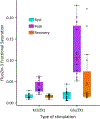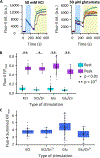Dissociated Hippocampal Neurons Exhibit Distinct Zn2+ Dynamics in a Stimulation-Method-Dependent Manner
- PMID: 32013397
- PMCID: PMC7251562
- DOI: 10.1021/acschemneuro.0c00006
Dissociated Hippocampal Neurons Exhibit Distinct Zn2+ Dynamics in a Stimulation-Method-Dependent Manner
Abstract
Ionic Zn2+ has increasingly been recognized as an important neurotransmitter and signaling ion in glutamatergic neuron pathways. Intracellular Zn2+ transiently increases as a result of neuronal excitation, and this Zn2+ signal is essential for neuron plasticity, but the source and regulation of the signal is still unclear. In this study, we rigorously quantified Zn2+, Ca2+, and pH dynamics in dissociated mouse hippocampal neurons stimulated with bath application of high KCl or glutamate. While both stimulation methods yielded Zn2+ signals, Ca2+ influx, and acidification, glutamate stimulation induced more sustained high intracellular Ca2+ and a larger increase in intracellular Zn2+. However, the stimulation-induced pH change was similar between conditions, indicating that a different cellular change is responsible for the stimulation-dependent difference in Zn2+ signal. This work provides the first robust quantification of Zn2+ dynamics in neurons using different methods of stimulation.
Keywords: Zinc imaging; calcium imaging; hippocampal culture; neurotransmitters; pH imaging; signaling.
Conflict of interest statement
The authors declare no competing financial interest.
Figures




Similar articles
-
Cytosolic acidification and intracellular zinc release in hippocampal neurons.J Neurochem. 2012 May;121(3):438-50. doi: 10.1111/j.1471-4159.2012.07695.x. Epub 2012 Mar 15. J Neurochem. 2012. PMID: 22339672 Free PMC article.
-
Cytosolic zinc release and clearance in hippocampal neurons exposed to glutamate--the role of pH and sodium.J Neurochem. 2011 Apr;117(2):231-43. doi: 10.1111/j.1471-4159.2011.07194.x. Epub 2011 Mar 1. J Neurochem. 2011. PMID: 21255017 Free PMC article.
-
Preventive Effect of 3,5-dihydroxy-4-methoxybenzyl Alcohol (DHMBA) and Zinc, Components of the Pacific Oyster Crassostrea gigas, on Glutamatergic Neuron Activity in the Hippocampus.Biol Bull. 2015 Dec;229(3):282-8. doi: 10.1086/BBLv229n3p282. Biol Bull. 2015. PMID: 26695827
-
Insight into cognitive decline from Zn2+ dynamics through extracellular signaling of glutamate and glucocorticoids.Arch Biochem Biophys. 2016 Dec 1;611:93-99. doi: 10.1016/j.abb.2016.06.021. Epub 2016 Jul 5. Arch Biochem Biophys. 2016. PMID: 27392455 Review.
-
Zinc signaling in the hippocampus and its relation to pathogenesis of depression.Mol Neurobiol. 2011 Oct;44(2):166-74. doi: 10.1007/s12035-010-8158-9. Epub 2010 Dec 15. Mol Neurobiol. 2011. PMID: 21161611 Review.
Cited by
-
Intracellular zinc signaling influences NMDA receptor function by enhancing the interaction of ZnT1 with GluN2A.Neurosci Lett. 2022 Nov 1;790:136896. doi: 10.1016/j.neulet.2022.136896. Epub 2022 Oct 3. Neurosci Lett. 2022. PMID: 36202195 Free PMC article.
-
Transient Zn2+ deficiency induces replication stress and compromises daughter cell proliferation.Proc Natl Acad Sci U S A. 2024 May 7;121(19):e2321216121. doi: 10.1073/pnas.2321216121. Epub 2024 Apr 30. Proc Natl Acad Sci U S A. 2024. PMID: 38687796 Free PMC article.
-
Single molecule microscopy to profile the effect of zinc status on transcription factor dynamics.Sci Rep. 2022 Oct 22;12(1):17789. doi: 10.1038/s41598-022-22634-x. Sci Rep. 2022. PMID: 36273101 Free PMC article.
-
Tools and techniques for illuminating the cell biology of zinc.Biochim Biophys Acta Mol Cell Res. 2021 Jan;1868(1):118865. doi: 10.1016/j.bbamcr.2020.118865. Epub 2020 Sep 24. Biochim Biophys Acta Mol Cell Res. 2021. PMID: 32980354 Free PMC article. Review.
-
Neuronal signalling of zinc: from detection and modulation to function.Open Biol. 2022 Sep;12(9):220188. doi: 10.1098/rsob.220188. Epub 2022 Sep 7. Open Biol. 2022. PMID: 36067793 Free PMC article. Review.
References
-
- Andreini C; Banci L; Bertini I; Rosato A Counting the Zinc-Proteins Encoded in the Human Genome. J. Proteome Res 2006, 5 (1), 196–201. - PubMed
-
- Levaot N; Hershfinkel M How Cellular Zn2+ Signaling Drives Physiological Functions. Cell Calcium 2018, 75, 53–63. - PubMed
-
- Claiborne BJ; Rea MA; Terrian DM Detection of Zinc in Isolated Nerve Terminals Using a Modified Timm’s Sulfide-Silver Method. J. Neurosci. Methods 1989, 30 (1), 17–22. - PubMed
-
- Frederickson CJ; Danscher G Zinc-Containing Neurons in Hippocampus and Related CNS Structures. Prog. Brain Res 1990, 83, 71–84. - PubMed
Publication types
MeSH terms
Substances
Grants and funding
LinkOut - more resources
Full Text Sources
Miscellaneous

